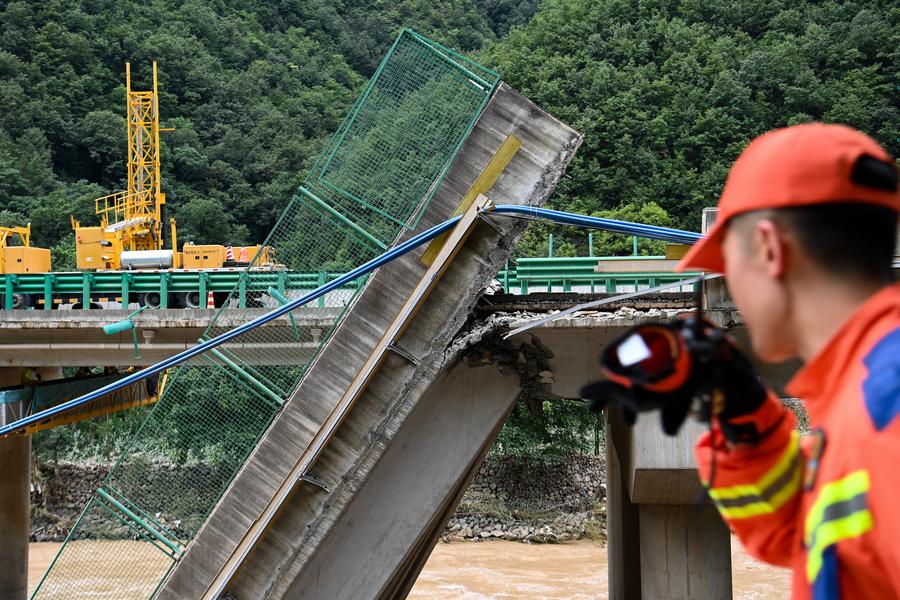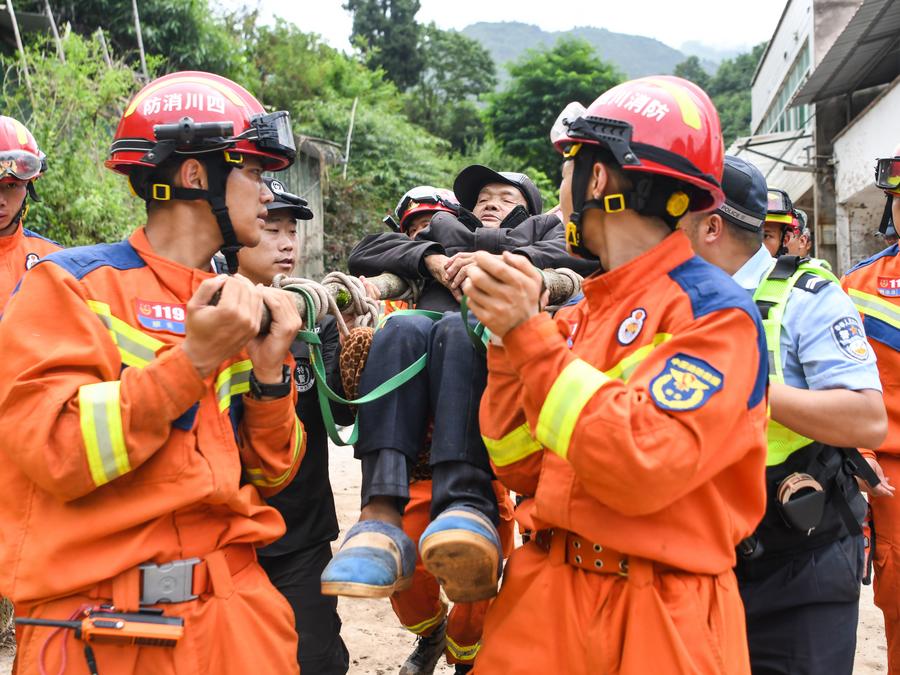

* Heavy rainfall has wreaked havoc across wide swaths of China, causing severe casualties, disrupting traffic and forcing hundreds of thousands to evacuate.
* Central and local authorities are moving swiftly to allocate all resources at their disposal to the ongoing relief and restoration efforts.
BEIJING, July 24 (Xinhua) -- China is mobilizing nationwide efforts to combat torrential rains, heavy flooding and other natural disasters as the country has entered the critical flood season, which normally runs from late July to early August.
Over the past few weeks, heavy rainfall has wreaked havoc across wide swaths of China, causing severe casualties, disrupting traffic and forcing hundreds of thousands to evacuate. Emergency responses to flooding have been activated in many regions across the country.
More than 20 vehicles plunged into the Jinqian River late Friday after the collapse of a 40-meter section of a highway bridge in Zhashui County of Shangluo City, northwest China's Shaanxi Province, following a flash flood triggered by a heavy rainstorm.
So far, rescuers have found the bodies of 15 victims. Thousands of rescue workers and volunteers are still searching for the missing.
Shortly after the disaster, President Xi Jinping urged all-out rescue and relief efforts to safeguard people's lives and property.

Rescuers work at the site of a bridge collapse in Zhashui County in Shangluo City, northwest China's Shaanxi Province, July 20, 2024. (Xinhua/Zou Jingyi)
The immediate priority is to carry out rescue operations, make every effort to search for the missing and minimize casualties, Xi, also general secretary of the Communist Party of China Central Committee and chairman of the Central Military Commission, said in an instruction.
He stressed that as the critical period of flood control approaches, it is imperative for regions and relevant departments to be extra vigilant, fulfill their duties diligently, improve monitoring systems and early warning mechanisms, strengthen inspections, and implement various measures meticulously to guarantee the safety of people's lives and property.
Another deadly disaster occurred early Saturday morning, when heavy downpours caused flash flooding at a local river in Ya'an City, southwest China's Sichuan Province, that seriously damaged over 40 houses in a village.
By Monday evening, rescue workers had found the bodies of 14 people, with 25 others still missing. Rescuers are using drones, sniffer dogs and life detectors to continue the search and rescue.

Rescuers evacuate a disaster-affected resident in Xinhua Village, Malie Township, Hanyuan County, Ya'an City, southwest China's Sichuan Province, July 21, 2024. (Xinhua/Wang Xi)
In response to the natural disasters that have affected various parts of China, central and local authorities are moving swiftly to allocate all resources at their disposal to the ongoing relief and restoration efforts, while taking measures to identify potential risks and prepare for secondary disasters.
The Office of State Flood Control and Drought Relief Headquarters and the Ministry of Emergency Management have held joint meetings to discuss flood prevention situations with the China Meteorological Administration and ministries of water resources, natural resources, and housing and urban and rural development.
They have also coordinated flood prevention and relief work in disaster-hit provinces via video conferences, while working groups have been dispatched to the provinces to assist and guide disaster prevention and response.
On Sunday, the National Development and Reform Commission, China's top economic planner, said it has allocated 350 million yuan (about 49 million U.S. dollars) from the central budget to aid disaster relief and restoration efforts in flood-stricken Henan, Shaanxi and Sichuan provinces.
The money will be used to fund the emergency recovery of flood-damaged schools, hospitals and flood control facilities in those provinces.

Rescuers transfer stranded residents in Pingjiang County, central China's Hunan Province, July 2, 2024. (Xinhua/Chen Sihan)
After the collapse of the highway bridge in Shangluo, Vice Premier Zhang Guoqing led a working team to the site to guide rescue efforts. He urged more efforts to search for the missing.
As the current flood season features high risks of geological disasters, all regions should screen for and rectify potential risks along highways and railways, Zhang said, calling for strengthened monitoring, early warning, and timely traffic control to minimize casualties.
On Sunday, the vice premier also visited the flood-hit Xinhua village, which is located in Hanyuan County under Ya'an City, Sichuan, and inspected a local hospital and the temporary relocation site for those affected by the disaster.
In Sichuan's flood-hit areas, post-disaster recovery efforts are in full swing. Power supply to 5,399 households has been fully restored as of 8 a.m. Tuesday, and seven 10kV lines in Hanyuan have been repaired.
A total of 248 emergency repair personnel, 75 repair vehicles and six emergency power supply vehicles have been deployed to support the disaster relief and power restoration efforts in Hanyuan.
In China's coastal regions, local authorities are bracing for the impact of Typhoon Gaemi, the third typhoon of this year. It was located 260 km southeast of Taiwan's Yilan County at 5 a.m. Wednesday and is expected to make landfall along the coast of central and northern Taiwan on Wednesday night.
Lin Xiaohong, chief forecaster at the Fujian provincial meteorological observatory, said that heavy rainfall is anticipated across most of the province, with the most intense precipitation likely to occur in the central and northern regions.
Cumulative rainfall is projected to range from 150 to 350 millimeters, with some areas experiencing over 600 millimeters, Lin added.
点击右上角![]() 微信好友
微信好友
 朋友圈
朋友圈

请使用浏览器分享功能进行分享
